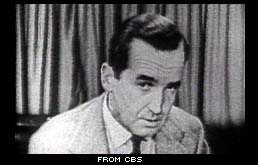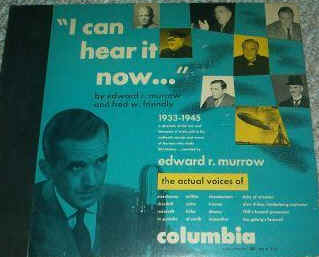|
The Broadcasts of A Resource for ©2005 |
 |

Background: One of the best selling recordings (albums) in 1948 was
“I Can Hear It Now 1933-1945,” a collaboration between producer
Fred Friendly and Ed Murrow.
The I Can Hear It Now records, which interwove historical events and
speeches with Murrow narration, became such a commercial success
that the partnership developed a radio series for CBS that also creatively
used taped actualities. The weekly Hear It Now was modeled on a
magazine format, with a variety of “sounds” of current events, such
as artillery fire from Korea and an atom smasher at work, illuminated
by Murrow and other expert columnists. (Source)
During the postwar economic boom of the early 1950s, it appeared that television could take over as the main source for news and entertainment.
When Murrow began his Hear It Now radio program, a weekly news
program using “taped actualities,” the radio audience was still larger
than that of television, according to the Nielsen ratings system. By 1955,
the television audience outpaced radio by just over 50%. Although Murrow
was a reluctant participant, casting a wary eye on the new medium, he
began a television version of his radio program entitled See It Now in
November 1951. As it was Murrow’s perception that television lacked
real ideas, he teamed with news producer Fred Friendly and set about
creating weekly news broadcasts of “personal interviews, overseas
reports, biographical features, human interest stories, [and] documentary features.” They were a perfect combination; Friendly supplied “class appeal” while Murrow was the perfect “cool host” for the new “cool medium,”
which was how media guru Marshall McLuhan would later describe
television. (Source)



